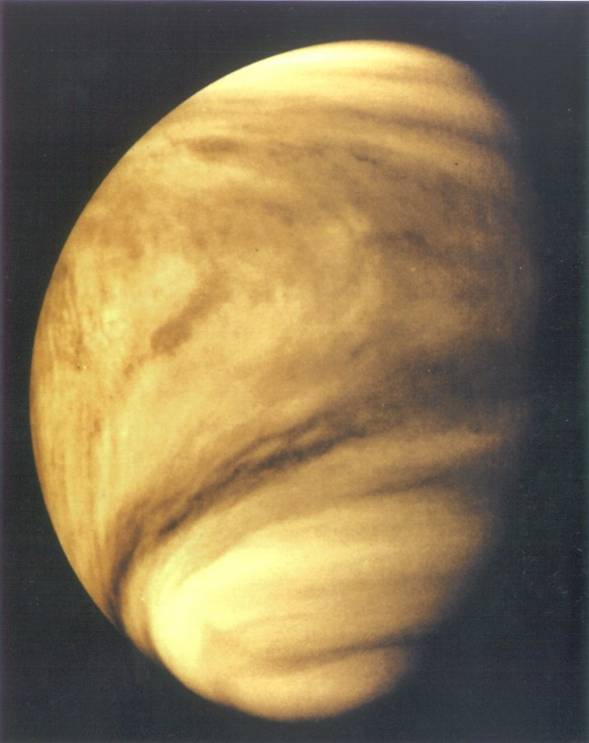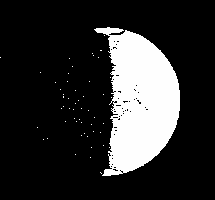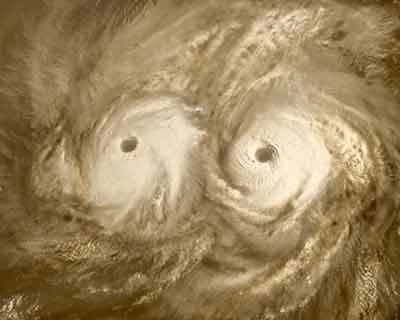
Hollow Planets, Venera 9, and the
Bhagavatam

By Dean Dominic De Lucia
This picture of Venus, taken by the Venera
13 space probe, corresponds to astronomer’s typical descriptions of the planet-
that it is a lifeless desert. Does such a description invalidate the Puranic
descriptions of life on other planets, including the ones along “ Bhu Mandala,”
the plane of the planetary orbits, our solar system?
Maybe the question really is, can we trust
this picture? The Venera 9 lander, for example, passed through an upper
atmosphere in which clouds swirl around at 360 kilometers per hour—the lander
reported a surface temperature of 900* F. We are assured that the lander carried
an ample cooling system for its mission, but we all may want to ask what
material the parachute was made of! It opened up at 60 kilometers above the
surface of the planet. Even assuming that the craft was able to parachute
through the 360 kilometer per hour winds found in the Venusian stratosphere, the
question remains: What could that parachute have been made of that it did not
melt nor burn during a 60 kilometer descent at 900* F? NASA ( Never A Straight
Answer ) seems to have met its match in the Russian space agency.
The Bhagavat Purana paints a different
description of the planet. In the ninth canto, 18th chapter, a narration
describes the activities of Devayani, the daughter of Shukra- the predominating
regent of the planet Venus.
There, a palace garden is described full of
lotuses, and trees of flowers and fruits, inhabited by sweetly singing birds and
bumble bees. It is described that lotus-eyed girls took a walk along the bank of
a reservoir. At one point in the narration, Shukra-Acharya, Devayani’s father,
made a comment about grains in the field. According to this description, Venus
seems to harbor life as on Earth.
In fact, according to the Puranic
descriptions, there is life and activity on all the planets. For example, in the
Bhagavat Purana, Canto 4, Chapter 20, Text 35 - 36, a reference is made to the
way in which Maharaj Prithu, a king of the Earth, paid his respects to visitors
from various celestial planets, and then a reference is made to the inhabitants
of the earthly planets.
Now first of all, the reader will note that
the text refers to earthly planets, in the plural. In the Vedic literature, one
term used to refer to the Earth is Bhu Mandala, which means the " circle of
the Sun, " which seems to refer to the planets along the plane of the solar
system, as pointed out by Dr. Richard L. Thompson in his book “Mysteries of
the Sacred Universe.” This is why the plural is used, the planets in the solar
system are somehow grouped together in this sense because they are all on the
same orbital plane. It is interesting, though, that we don’t apparently see
inhabitants on any of the other planets in the solar system.
In fact, the Apollo astronauts have
supposedly gone to the Moon and found no life there. Through their telescopes
and space probes, astronomers tell us that there is no life on the other planets
such as Mercury, Venus and Mars, either.
A C Bhaktivedanta Swami never agreed with
such conclusions. In his purport to Text 26, Chapter 18, Canto 4 of the Bhagavat
Purana, Bhaktivedanta Swami states that “ According to the Vedic literature,
it is not true that the Moon does not produce food or that no living entity is
living there.” In the purport to Canto 4, Chapter 22, Text 54, Bhaktivedanta
Swami writes: “ The Vedic literature, however, repeatedly informs us that the
Moon is full of highly elevated inhabitants who are counted amongst the demigods.
We are therefore always in doubt about what kind of moon adventure the modern
scientists of this Earth have undertaken.” Also, in his purport to the
above-mentioned Text 6 from Canto 4, Chapter 20, of the Bhagavat Purana. A C
Bhaktivedanta Swami, Prabhupada, mentions: “ In modern scientific society the
idea is very prevalent that there is no life on other planets but that only on
this Earth do living entities with intelligence and scientific knowledge exist.
The Vedic literatures, however, do not accept this foolish theory. ... The Vedas
give information that in all planets ... there are varieties of living entities
... We have information from the Vedic literature that in each and every planet,
both material and spiritual, there are living entities of varied intelligence.”
It is important for followers of the
Puranic version to understand these statements so that their faith in the entire
Vedic presentation may not be shaken. We can consider the difference of opinion
between these Puranic statements and modern scientific allegations, that the
planets are uninhabited and lifeless, by considering whether the Apollo
astronauts really went to the Moon, whether or not there might actually be
artificial artifacts on the surface of the Moon, and whether or not the key to
understanding the nature of the Puranic statements might not lie in the fact
that the planets are hollow.
Recently, there has been quite a bit of
private investigation into the validity of NASA space probe and Apollo
photographs. Much of the results appear on the internet. Apollo debunkers point
out various photographic anomalies which challenge NASA claims. For example,
there is a famous picture of the rocket motor on the Lunar Excursion Module,
which was supposedly turned off two meters above the surface of the Moon. The
anomaly has to do with the fact that the picture shows no disturbance on the
soil underneath it. There is also a famous photograph, taken from an ELEVATED
angle, of the astronauts on the Moon with their hands free and the LEM in the
field of the picture, but nobody there to take the picture. There are divergent
shadows on fairly level terrain, although only one light source exists on the
Moon, the Sun. Glare is seen in the Apollo pictures, even though glare is caused
by the atmosphere and the Moon supposedly has none, and the NASA sign
-specifically the sign on the side of the LEM away from the Sun- is illuminated
in various film clips, indicating spot lights or such. There is more- but for
reasons such as these, we may take a dim view about NASA claims of lifelessness
on the Moon and withold any judgement again the Vedic statements.
Perhaps the key to understanding the
difference between the Puranic version and the version of modern astronomers
lies in the following statement which Bhaktivedanta Swami made in the summary
study of the Bhakti Rasamrita Sindhu. On page 11, he writes of how the yogi
" ... can enter into the sun planet simply by using the rays of the
sunshine." How unusual that he writes about living entities “ in “ the
planets. In the English language, it is very unusual to refer to a population
living “ in “ the planets. We always say “ on.” And we have already
pointed out that in the purport to the 4th Canto, Chapter 22, Verse 54, he
writes that “ the Moon is full of highly elevated inhabitants who are counted
amongst the demigods.” A planet “ full of “ inhabitants does not suggest
life on the surface of that planet, but rather within. Could it be that the
principal population of a planet lies in the planet’s interior, and that, for
example, the parks, lakes and lush vegetation described in the Puranas in
relation to the Moon, Venus and the other planets exist inside of the them,
along with the inhabitants? Such an understanding would completely vindicate
those puranic statements which seem so fantastic that they are unintelligible to
us currently, and establish new-found validity for the puranic astronomical
scheme of things.
Does any support exist of such Puranic
descriptions? The following NASA photograph of Venus, number: 79-HC-46, seems to
do so insofar as it supports the Hollow Planets Theory. If Venus were hollow
then perhaps in this way the Vedic civilization could exist- not " on
" Venus, but within.

Note: This picture was culled out of NASA
files by Jan Lamprecht and appears in his book “ Hollow Planets.” Both the
picture as well as the arguments in relation to it have been adapted from Mr.
Lamprecht's book Hollow Planets.
We can start with evidence of polar
openings. Astronomers tell us that the atmospheric level above the Venusian
North Pole is 15 kilometers lower than the rest of the planet. Is this
depression indicative of atmosphere being sucked into Venus, just as the cloud
billows superimposed on the southern pole indicate a huge, spiraling outdraft?
Does ventilation occur through the Venusian poles?
The reader will notice how the curvature of
the planet’s atmosphere changes as his/her eye approaches the Southern pole.
Several, rounded, twirling, cloud billows are obvious, and there seem to be
several folds. They rise out of the Southern extremity and elongate the
atmosphere. Venus does, in fact, experience a rising and falling of its
atmosphere by as much as 1.1%. That represents a huge expansion given the fact
that the diameter of the Venusian globe is supposed to be 7,700 miles. Could the
expansion of the Venusian atmosphere and the billowing at
the poles be a symptom of the planet’s breathing through polar holes?
[ Picture credit: British Astronomical
Association, culled by Jan Lamprecht
]
 On the 29th of
March, 1873, W.F. Denning observed a
depression in the polar regions which he described as looking like a “ small
“ crater. Is Denning's depression related to a polar opening? In the early
1970s this depression was seen again by a number of British and American
astronomers. Another phenomena seen and even photographed by NASA space craft is
the polar “ collar. “ This is a ring which seems to extend the points of
gibbous Venus, at the very polar regions. Could this polar collar be linked to
the existence of Polar openings on Venus?
On the 29th of
March, 1873, W.F. Denning observed a
depression in the polar regions which he described as looking like a “ small
“ crater. Is Denning's depression related to a polar opening? In the early
1970s this depression was seen again by a number of British and American
astronomers. Another phenomena seen and even photographed by NASA space craft is
the polar “ collar. “ This is a ring which seems to extend the points of
gibbous Venus, at the very polar regions. Could this polar collar be linked to
the existence of Polar openings on Venus?
" Radar pictures recently taken of
Venus show two almost perfectly round depressions that are antipodes of each
other. One has a diameter that is 40 percent as great as that of the planet
itself. The other has a diameter nearly 30 percent as great. Incredibly, these
were explained away as being impact craters. It is difficult to believe that
even the scientific community has any members of sufficient mental vacuity to
endorse such an explanation. Yet the author knows an honored member intimately
who insists this is what they are. As anyone who has even a modicum of
intelligence should realize, an impact crater will have a depth that is a
reasonable percentage of its diameter, especially if the missile does not bounce
off and sinks below the surface. An impact capable of producing a crater with
such a diameter would completely shatter even a solid planet. The impossible
coincidence that a planet would have two such craters nearly the exact antipodes
of each other has been cheerfully ignored.
The only possible explanation is that these
" depressions " are giant openings into the hollow interior. The
energies being radiated from these openings would deflect radar to the extent of
creating the illusion of their being shallow sinks. Venus, being closer to the
sun and in full view of the binary, would require much larger openings to
dissipate the heat that would build up in the interior.
And in fact, as can be seen by this European Space Agency image below, culled by Luiz Aparicio of Portugal, the Venusian opening seeems to be binary, which would certainly help to dissipate the energies that build up within the planet.

Other claims by NASA with regard to Venus
which are steeped in contradictions are those of the dense clouds surrounding
Venus consisting of sulfuric acid, and that the surface temperature is about
1000° F. Early pictures of Venusian terrain sent back by a probe which soft
landed on the surface show a landscape very similar to that of the earth or the
Moon. Rocks were shown with sharp edges and there was the usual evidence of
normal ground erosion. The type of erosion that would be produced by a
combination of high concentrations of sulfuric acid and 1000° F would reduce
everything on the surface to a blob. The clouds on Venus undoubtedly consist of
a tremendous mantle of water vapor and droplets, which would protect the surface
and promote earth-like conditions." ( Chapter 15 )
Do the warmth and brightness of the
Venusian poles tell a tale of polar openings? (Lipstick on your collar, ( polar
collar ) tells a tale on you!) The infrared radiometer on the Pioneer Venus
Orbiter discovered an elongated emanation from the northern pole, 4,000 miles
across, stretching down as far as 70* latitude on each side of the planet.
According to Schubert, it is a temperature feature, and it is bright. The
atmospheric depression falls within this feature. What could cause these
phenomena at the Venusian poles? Air currents to the interior as well as
interior illumination answer the question well.
But the strangest sighting of Venus ever
made was that by the very famous and respected German astronomer, Maedler in the
1800's. He once observed Venus as looking like a comet! His drawing of Venus
showed two beams of light emanating from both its polar regions. These beams of
light were pointed towards the Sun, and gave Venus the appearance of a comet
with two tails! At the time Maedler conducted several tests by changing
eye-pieces, and moving his telescope to ensure that what he was seeing was real.
It remains to this day the strangest sighting ever made of this planet. So there
is a varied base of evidence which reinforces the theory of polar openings on
Venus.
Furthermore, not only does Venusian
phenomena help to establish the Hollow Planets Theory, but the hollow planets
theory helps to explain Venusian phenomena. For example, the long standing
enigma of the Y marking on Venus can now be explained. The powerful torrents in
the NASA picture end up being deflected in the direction in which the planet is
rotating, caught up in a Coriolis effect. This can be seen in the picture in the
form of a dark streak ( ultraviolet ) which originates in the South Polar cloud
twirls, in the NASA picture, and then streaks around the planet and lines itself
around the equator. It is joined by a similar dark streak from the Northern
hemisphere of the planet.
If hollow Earth advocates, who are not
professional astronomers, can arrive at such conclusions from the little bit of
data which makes it through NASA censorship, then how much more must NASA really
know? Why is it that Venus has been entirely mapped by radar except for the
poles? Even commercial globes of Venus, made available in catalogues and stores,
simply show flatness at the polar regions. These regions are places where
inordinate illumination is observed, where the cloud level dips, where huge
depressions have been observed with high rims around them, areas across which
the gibbous horns from the illuminated side of Venus project themselves in an
exaggerated manner, which are the sink hole of vortices and which are the origin
of wind patterns that cover the Venusian globe.
Maybe the Russian space agency hasn’t
bested Never A Straight Answer ( NASA ) after all, though it might be a close
tie.
The conclusions are obvious. Though readers
of Vedic literature do have special
reasons to accept that civilized life on Venus exists in the light of the
Puranic descriptions, certainly no one should deny the possibility of an
advanced, human civilization on or inside of Venus until the interior of the
planet is peered into through the polar openings, and not by means of NASA
probes or any Russian space agency.
Maricha and Other Shapeshifters